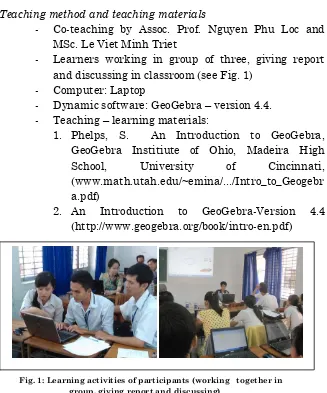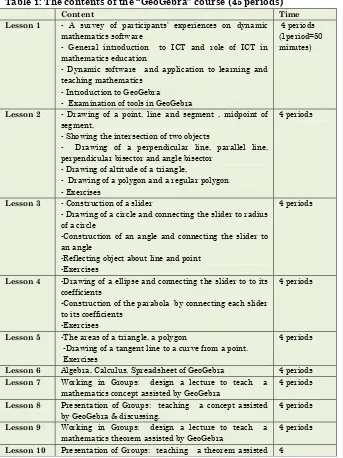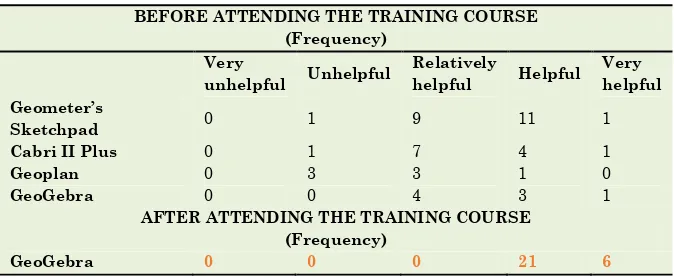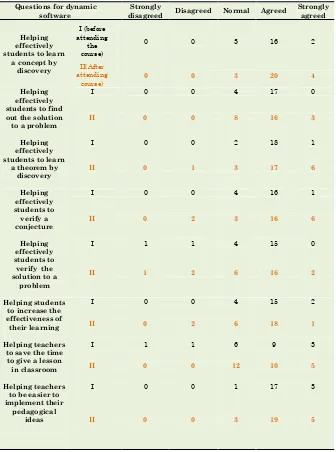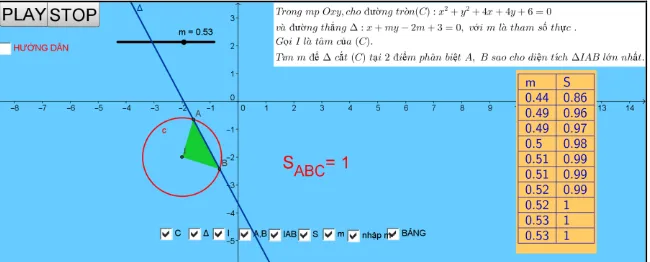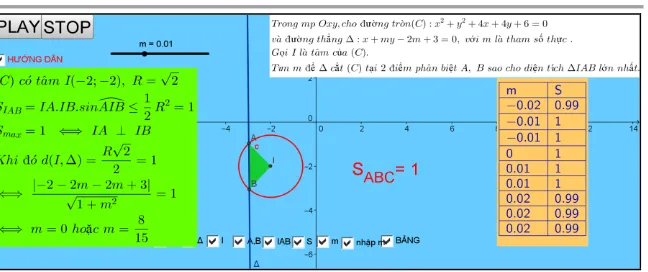ISSN 2286-4822 www.euacademic.org
Impact Factor: 3.1 (UIF)
DRJI Value: 5.9 (B+)
Dynamic Software “Geogebra” for Teaching
Mathematics: Experiences from a Training Course
in Can Tho University
NGUYEN PHU LOC, PhD.
Associate Professor in Mathematics Education School of Education, Can Tho University Vietnam
LE VIET MINH TRIET, MSc.
Doctoral student in Mathematics Education Pacific College, Can Tho City Vietnam
Abstract:
Key words: GeoGebra, dynamic mathematics software, ICT, mathematics education, educational technology.
1. Introduction
In Vietnam, the use of ICT as a tool to increase the quality of secondary education was concerned for many years ago. Particularly for teaching mathematics, secondary school teachers were learned some dynamic software packages which could assist their instruction in an effective way. However, through our observations of several classrooms in which teachers used dynamic software last years, we discovered that applying software of teachers to their jobs had some limitations. It seemed they only used the software to construct figures to illustrate intuitively their lectures; there were only a few teachers who knew how to help students to discover mathematics knowledge by themselves although the dynamic software packages “can be used to encourage discovery, experimentation and visualization in traditional teaching of mathematics” (Diković , 2009). So, as a mathematics education lecturers, we found it necessary to design the dynamic software “GeoGebra” course to improve the ability of secondary school teachers of mathematics in applying dynamic software packages to teaching mathematics.
2. Why to choose GeoGebra
We chose GeoGebra because of the following reasons:
2. GeoGebra “combines dynamic geometry, algebra, calculus, and spreadsheet features (which other packages treat separately) into a single easy-to-use package” (Hohenwarter & Preiner, 2007). This strong point makes it comfortable for learning and teaching mathematics in Vietnamese secondary schools. Teachers and students can use the software for teaching and learning all topics of mathematics in schools. For the students,
“GeoGebra can help students grasp experimental, problem-oriented and research-oriented learning of mathematics, both in the classroom and at home. Students can simultaneously use a computer algebra system and an interactive geometric system; by doing this, they can increase their cognitive abilities in the best way” (Diković, 2009).
3. GeoGebra has a large community with users and
developers from different countries around the world (Tatar, 2013). Thanks to it, it is easy for teachers and students to exchange ideas each other.
3. Course “GeoGebra”
Goal: To help participants using GeoGebra to support their teaching mathematics in an effective way. Focus of the course is to apply GeoGebra to teaching plane geometry to Grade 10 students –Vietnam.
Objectives: After finishing the training course, the learner will
be able:
- To identify the functions of tools of GeoGebra
- To construct figures having “dynamic” property by GeoGebra
concepts and theorems with GeoGebra in an active way.
- To guide secondary school students to solve
mathematics problems with the assistance of GeoGebra.
-Teaching method and teaching materials
- Co-teaching by Assoc. Prof. Nguyen Phu Loc and MSc. Le Viet Minh Triet
- Learners working in group of three, giving report and discussing in classroom (see Fig. 1)
- Computer: Laptop
- Dynamic software: GeoGebra – version 4.4. - Teaching – learning materials:
1. Phelps, S. An Introduction to GeoGebra,
GeoGebra Institiute of Ohio, Madeira High
School, University of Cincinnati,
(www.math.utah.edu/~emina/.../Intro_to_Geogebr a.pdf)
2. An Introduction to GeoGebra-Version 4.4
(http://www.geogebra.org/book/intro-en.pdf)
4. The contents of the course
The course of GeoGebra consisted of contents as follows (see Table 1 ):
Table 1: The contents of the “GeoGebra” course (45 periods)
Content Time
Lesson 1 - A survey of participants’ experiences on dynamic mathematics software
- General introduction to ICT and role of ICT in mathematics education
- Dynamic software and application to learning and teaching mathematics
- Introduction to GeoGebra - Examination of tools in GeoGebra
4 periods (1period=50 minutes)
Lesson 2 - Drawing of a point, line and segment , midpoint of segment,
- Showing the intersection of two objects
- Drawing of a perpendicular line, parallel line, perpendicular bisector and angle bisector
- Drawing of altitude of a triangle,
- Drawing of a polygon and a regular polygon - Exercises
4 periods
Lesson 3 - Construction of a slider
- Drawing of a circle and connecting the slider to radius of a circle
-Construction of an angle and connecting the slider to an angle
-Reflecting object about line and point -Exercises
4 periods
Lesson 4 -Drawing of a ellipse and connecting the slider to to its coefficients
-Construction of the parabola by connecting each slider to its coefficients
-Exercises
4 periods
Lesson 5 -The areas of a triangle, a polygon
-Drawing of a tangent line to a curve from a point. Exercises
4 periods
Lesson 6 Algebra, Calculus, Spreadsheet of GeoGebra 4 periods
Lesson 7 Working in Groups: design a lecture to teach a mathematics concept assisted by GeoGebra
4 periods
Lesson 8 Presentation of Groups: teaching a concept assisted by GeoGebra & discussing.
4 periods
Lesson 9 Working in Groups: design a lecture to teach a mathematics theorem assisted by GeoGebra
4 periods
by GeoGebra & discussing.
Lesson 11 Working in Group: Solving a problem assisted by GeoGebra & presentations
4 periods
Survey A survey of participants’ opinions on GeoGeobra 1 period
5. Participants
Participants were 27 secondary school teachers of mathematics who are pursuing master program of mathematics education in Can Tho University. They have learned some of dynamic software while working at secondary schools in Mekong Delta - Vietnam (see Table 2).
Table 2: A number of participants using dynamic mathematics
software (n=27) How often to use
(Frequency)
Never Rarely Sometime Often
Very often
Geometer’s Sketchpad 0 0 12 8 2
Cabri II Plus 5 0 8 3 0
Geoplan 9 1 0 1 1
GeoGebra 8 0 2 2 0
Comment: Table 2 showed that Geometer’s Sketchpad have
6. Comparison of participants’ opinions on dynamic software before and after attending the training course
In order to know what the participants think about the GeoGebra, and to determine the effectiveness of the training course. We conducted the survey of the participants both before and after attending the training course. The results were presented as follows:
Question 1:Was it easy for you to use the dynamic software?
Answer:see Table 3
Table 3: A number of participants’ answers to the question 1 (n=27) BEFORE ATTENDING THE TRAINING COURSE
(Frequency) Very
difficult
Difficult Relatively easy
Easy Very easy Geometer’s
Sketchpad
0 5 10 7 0
Cabri II Plus 0 3 4 5 0
Geoplan 2 3 0 2 0
GeoGebra 1 2 2 2 0
AFTER ATTENDING THE TRAINING COURSE (Frequency)
GeoGebra 0 0 3 19 5
Comment: Under the guidance of lectures, participants had
opportunities to operate GeoGebra. So that, 100% of participants agreed that GeoGebra was trouble – free to use and was easier to operate than the others.
Question 2: What are your opinions on the interface of the
following software to the user
Table 4: Participants’ opinions on the interface of the following software to the user (n=27)
BEFORE ATTENDING THE TRAINING COURSE (Frequency)
Very unfriendly
Unfriendly Relatively friendly
Friendly Very friendly Geometer’s
Sketchpad
0 1 10 11 0
Cabri II Plus 0 0 8 5 0
Geoplan 0 5 2 1 0
GeoGebra 0 1 4 4 0
AFTER ATTENDING THE TRAINING COURSE (Frequency)
GeoGebra 1 5 10 10 1
Comment: Aboutthe interface of the software to the user, after
finishing the course, the learners identified that friendly level of GeoGebra was equivalent to Geometer’s Sketchpad, which they have been familiar with.
Question 3: What are your opinions on the utility of functional
tools of the following software?
Answer: see Table 5
Table 5: Participants’ opinions on the utility of functional tools of the dynamic software (n=27)
BEFORE ATTENDING THE TRAINING COURSE (Frequency)
Very
unhelpful Unhelpful
Relatively
helpful Helpful
Very helpful Geometer’s
Sketchpad 0 1 9 11 1
Cabri II Plus 0 1 7 4 1
Geoplan 0 3 3 1 0
GeoGebra 0 0 4 3 1
AFTER ATTENDING THE TRAINING COURSE (Frequency)
GeoGebra 0 0 0 21 6
Comment: Table 5 gave us a result that after finishing the
Question 4: For the following questions, what are your opinions?
Answer: Table 6 presented both questions raised and
participants’ answers.
Table 6: A number of participants answering to each item (n=27)
Questions for dynamic
software disagreed Strongly Disagreed Normal Agreed Strongly agreed
Helping effectively students to learn
a concept by discovery
I (before attending
the course)
0 0 3 16 2
II(After attending
course)
0 0 3 20 4
Helping effectively students to find out the solution to a problem
I 0 0 4 17 0
II 0 0 8 16 3
Helping effectively students to learn
a theorem by discovery
I 0 0 2 18 1
II 0 1 3 17 6
Helping effectively students to verify a conjecture
I 0 0 4 16 1
II 0 2 3 16 6
Helping effectively students to verify the solution to a
problem
I 1 1 4 15 0
II 1 2 6 16 2
Helping students to increase the effectiveness of their learning
I 0 0 4 15 2
II 0 2 6 18 1
Helping teachers to save the time
to give a lesson in classroom
I 1 1 6 9 3
II 0 0 12 10 5
Helping teachers to be easier to implement their
pedagogical ideas
I 0 0 1 17 3
Helping teachers to increase the effectiveness of their teaching
I 0 0 3 16 2
II 0 2 4 15 6
Comment: After accomplishing the training course, the
participants were of the same opinion that the dynamic software GeoGebra assists teachers and students very well in teaching and learning mathematics in Vietnamese secondary schools.
6. An illustration: a case of finding out the solution of a problem
One group of participants suggested the following problem that with the assistance of GeoGebra, students can find out the strategy for solving.
Problem: In coordinate system Oxy, let (C) be a circle having
the equation: x2+y2+4x+4y+6 = 0 and its center is I, and a
straight line (
): x+my-2m +3 = 0. In case of (
) intersecting (C) in A and B, to determine the value of m such that the area of the triangle IAB obtains the greatest value.Finding out strategy for solving with assistance of GeoGebra: The teacher could lead his student to find out the strategy for solving the problem as follows:
- Step 1: Look for the position of A and B where the area of the triangle IAB (S) obtains the greatest value (Smax) by moving slider (m) to (
) runs andseeing spreadsheet. Thanks so, we can detect two cases of A and B where S is Smax (=1) (see Fig. 1 and
Fig. 2).
- Step 3: Select a suitable formula to compute S: S = ^
AIB
sin
IB
.
IA
2
1
.
Because sin
AIB
1
^
, Smax=IA
.
IB
2
1
.
IB
IA
(1)From (1), it is not difficult for students to discover how to solve the given problem (see Fig. 3).
Fig. 1: In the first case of A and B for the greatest area of the triangle IAB:
IA
IB
Fig. 2: In the second case of A and B for the greatest area of the triangle IAB:
IA
IB
Fig. 3: The solution to the problem
Conclusion
The above results showed that after finishing the training course, GeoGebra became the dynamic software that learners preferred to the other software. The learner have highly evaluated GeoGebra because it integrates dynamic geometry, algebra, calculus, and statistics into a single easy-to-use package; so it is helpful and comfortable for students and mathematics teachers. From experiences that we obtained as above, at a present time, we still are continuing to study GeoGebra so that in coming years, we can offer mathematics teachers of different provinces in the Mekong Delta (Vietnam) training courses on GeoGebra in an effective way.
REFERENCES
_______. “An Introduction to GeoGebra- version 4.4”.
http://www.geogebra.org/book/intro-en.pdf
Hohenwarter, M. & Preiner, J., 2007. Dynamic mathematics with GeoGebra. Journal of Online Mathematics and its
Applications. ID 1448, Vol 7, March 2007.
Phelps, S. “An Introduction to GeoGebra”, GeoGebra Institiute of Ohio, Madeira High School, University of Cincinnati, www.math.utah.edu/~emina/.../Intro_to_Geogebra.pdf Tatar, E. 2013. “The Effect of Dynamic Software on Prospective
Mathematics Teachers’ Perceptions Regarding
Information and Communication Technology”.
Australian Journal of Teacher Education, Vol 38, 12,
